Efficient Photoelectrochemical Water Splitting by Tailoring MoS2/CoTe Heterojunction in a Photoelectrochemical Cell
Abstract
:1. Introduction
2. Results and Discussion
2.1. Phase Analysis
2.2. Raman Analysis
2.3. Structural and Compositional Analysis
2.4. XPS Analysis
2.5. Alignment of Energy Levels
2.6. Photoelectrochemical Analysis
2.7. Mott–Schottky Plot
3. Experimental
3.1. Synthesis of MoS2
3.2. Synthesis of CoTe
3.3. Development of MoS2/CoTe Heterojunction Using Sonochemical Method
3.4. Characterization
3.5. Photoelectrochemical Measurements
4. Conclusions
Supplementary Materials
Author Contributions
Funding
Acknowledgments
Conflicts of Interest
References
- Pan, Q.G.; Zhang, C.; Xiong, Y.J.; Mi, Q.X.; Li, D.D.; Zou, L.L.; Huang, Q.H.; Zou, Z.Q.; Yang, H. Boosting Charge Separation and Transfer by Plasmon-Enhanced MoS2/BiVO4 p-n Heterojunction Composite for Efficient Photoelectrochemical Water Splitting. ACS Sustain. Chem. Eng. 2018, 6, 6378–6387. [Google Scholar] [CrossRef]
- Kumar, D.; Sharma, S.; Khare, N. Enhanced photoelectrochemical performance of NaNbO3 nanofiber photoanodes coupled with visible light active g-C3N4 nanosheets for water splitting. Nanotechnology 2020, 31, 135402. [Google Scholar] [CrossRef] [PubMed]
- Andreiadis, E.S.; Chavarot-Kerlidou, M.; Fontecave, M.; Artero, V. Artificial photosynthesis: From molecular catalysts for light-driven water splitting to photoelectrochemical cells. Photochem. Photobiol. 2011, 87, 946–964. [Google Scholar] [CrossRef]
- Shi, X.; Cai, L.; Ma, M.; Zheng, X.; Park, J.H. General Characterization Methods for Photoelectrochemical Cells for Solar Water Splitting. ChemSusChem 2015, 8, 3192–3203. [Google Scholar] [CrossRef] [PubMed]
- Osterloh, F.E. Inorganic nanostructures for photoelectrochemical and photocatalytic water splitting. Chem. Soc. Rev. 2013, 42, 2294–2320. [Google Scholar] [CrossRef]
- Murphy, A.; Barnes, P.; Randeniya, L.; Plumb, I.; Grey, I.; Horne, M.; Glasscock, J. Efficiency of solar water splitting using semiconductor electrodes. Int. J. Hydrogen Energy 2006, 31, 1999–2017. [Google Scholar] [CrossRef]
- Liao, J.; Sa, B.; Zhou, J.; Ahuja, R.; Sun, Z. Design of High-Efficiency Visible-Light Photocatalysts for Water Splitting: MoS2/AlN(GaN) Heterostructures. J. Phys. Chem. C 2014, 118, 17594–17599. [Google Scholar] [CrossRef]
- Li, M.; Chen, J.-S.; Routh, P.K.; Zahl, P.; Nam, C.-Y.; Cotlet, M. Distinct Optoelectronic Signatures for Charge Transfer and Energy Transfer in Quantum Dot-MoS2 Hybrid Photodetectors Revealed by Photocurrent Imaging Microscopy. Adv. Funct. Mater. 2018, 28, 1707558. [Google Scholar] [CrossRef]
- Kang, Z.; Yan, X.; Wang, Y.; Bai, Z.; Liu, Y.; Zhang, Z.; Lin, P.; Zhang, X.; Yuan, H.; Zhang, X.; et al. Electronic structure engineering of Cu2O film/ZnO nanorods array all-oxide p-n heterostructure for enhanced photoelectrochemical property and self-powered biosensing application. Sci. Rep. 2015, 5, 7882. [Google Scholar] [CrossRef] [Green Version]
- Liu, Y.; Yu, Y.-X.; Zhang, W.-D. MoS2/CdS Heterojunction with High Photoelectrochemical Activity for H2Evolution under Visible Light: The Role of MoS2. J. Phys. Chem. C 2013, 117, 12949–12957. [Google Scholar] [CrossRef]
- Koo, B.; Shin, G.H.; Park, H.; Kim, H.; Choi, S.-Y. Vertical-tunneling field-effect transistor based on MoTe2/MoS2 2D–2D heterojunction. J. Phys. D Appl. Phys. 2018, 51, 475101. [Google Scholar] [CrossRef]
- Nardi, M.V.; Timpel, M.; Ligorio, G.; Zorn Morales, N.; Chiappini, A.; Toccoli, T.; Verucchi, R.; Ceccato, R.; Pasquali, L.; List-Kratochvil, E.J.W.; et al. Versatile and Scalable Strategy To Grow Sol-Gel Derived 2H-MoS2 Thin Films with Superior Electronic Properties: A Memristive Case. ACS Appl. Mater. Interfaces 2018, 10, 34392–34400. [Google Scholar] [CrossRef] [PubMed]
- Wang, P.; Yue, W.; Lu, Z.; Zhang, G.; Zhu, L. Friction and wear properties of MoS2-based coatings sliding against Cu and Al under electric current. Tribol. Int. 2018, 127, 379–388. [Google Scholar] [CrossRef]
- Sinha, A.; Dhanjai; Tan, B.; Huang, Y.; Zhao, H.; Dang, X.; Chen, J.; Jain, R. MoS2 nanostructures for electrochemical sensing of multidisciplinary targets: A review. TrAC Trends Anal. Chem. 2018, 102, 75–90. [Google Scholar] [CrossRef]
- Verdier, P.; Vasilevskiy, D.; Turenne, S.; Masut, R.A. Microstructure and Thermoelectric Properties of Hot Extruded Sb-Doped Mg2Si Using MoS2 Nano-particles as Lubricant. J. Electron. Mater. 2018, 47, 6833–6841. [Google Scholar] [CrossRef]
- Jian, W.; Cheng, X.; Huang, Y.; You, Y.; Zhou, R.; Sun, T.; Xu, J. Arrays of ZnO/MoS2 nanocables and MoS2 nanotubes with phase engineering for bifunctional photoelectrochemical and electrochemical water splitting. Chem. Eng. J. 2017, 328, 474–483. [Google Scholar] [CrossRef]
- Velicky, M.; Bissett, M.A.; Woods, C.R.; Toth, P.S.; Georgiou, T.; Kinloch, I.A.; Novoselov, K.S.; Dryfe, R.A. Photoelectrochemistry of Pristine Mono- and Few-Layer MoS2. Nano Lett. 2016, 16, 2023–2032. [Google Scholar] [CrossRef] [Green Version]
- Ge, L.; Han, C.; Xiao, X.; Guo, L. Synthesis and characterization of composite visible light active photocatalysts MoS2–g-C3N4 with enhanced hydrogen evolution activity. Int. J. Hydrogen Energy 2013, 38, 6960–6969. [Google Scholar] [CrossRef]
- Lu, X.; Jin, Y.; Zhang, X.; Xu, G.; Wang, D.; Lv, J.; Zheng, Z.; Wu, Y. Controllable synthesis of graphitic C3N4/ultrathin MoS2 nanosheet hybrid nanostructures with enhanced photocatalytic performance. Dalton Trans. 2016, 45, 15406–15414. [Google Scholar] [CrossRef]
- Yuan, X.; Wang, H.; Wang, J.; Zeng, G.; Chen, X.; Wu, Z.; Jiang, L.; Xiong, T.; Zhang, J.; Wang, H. Near-infrared-driven Cr(vi) reduction in aqueous solution based on a MoS2/Sb2S3 photocatalyst. Catal. Sci. Technol. 2018, 8, 1545–1554. [Google Scholar] [CrossRef]
- Pradhan, G.; Sharma, A.K. Anomalous Raman and photoluminescence blue shift in mono- and a few layered pulsed laser deposited MoS2 thin films. Mater. Res. Bull. 2018, 102, 406–411. [Google Scholar] [CrossRef]
- Chen, T.; Hao, G.; Kou, L.; Wang, C.; Zhong, J. Controllable epitaxial growth of MoSe2-MoS2 lateral heterostructures with tunable electrostatic properties. Nanotechnology 2018, 29, 484003. [Google Scholar] [CrossRef] [PubMed]
- Zhang, W.; Zhang, P.; Su, Z.; Wei, G. Synthesis and sensor applications of MoS2-based nanocomposites. Nanoscale 2015, 7, 18364–18378. [Google Scholar] [CrossRef]
- Sharma, S.; Kumar, A.; Singh, N.; Kaur, D. Excellent room temperature ammonia gas sensing properties of n-MoS2/p-CuO heterojunction nanoworms. Sens. Actuators B Chem. 2018, 275, 499–507. [Google Scholar] [CrossRef]
- Zhang, Y.; Zou, H.; Peng, J.; Duan, Z.; Ma, M.; Xin, X.; Li, W.; Zheng, X. Enhanced humidity sensing properties of SmFeO3-modified MoS2 nanocomposites based on the synergistic effect. Sens. Actuators B Chem. 2018, 272, 459–467. [Google Scholar] [CrossRef]
- Lee, H.S.; Ahn, J.; Shim, W.; Im, S.; Hwang, D.K. 2D WSe2/MoS2 van der Waals heterojunction photodiode for visible-near infrared broadband detection. Appl. Phys. Lett. 2018, 113, 163102. [Google Scholar] [CrossRef]
- Hossain, M.A.; Merzougui, B.A.; Alharbi, F.H.; Tabet, N. Electrochemical deposition of bulk MoS2 thin films for photovoltaic applications. Solar Energy Mater. Solar Cells 2018, 186, 165–174. [Google Scholar] [CrossRef]
- Zhang, J.; Lang, X.Y.; Zhu, Y.F.; Jiang, Q. Strain tuned InSe/MoS2 bilayer van der Waals heterostructures for photovoltaics or photocatalysis. Phys. Chem. Chem. Phys. 2018, 20, 17574–17582. [Google Scholar] [CrossRef]
- Yin, Z.; Chen, B.; Bosman, M.; Cao, X.; Chen, J.; Zheng, B.; Zhang, H. Au nanoparticle-modified MoS2 nanosheet-based photoelectrochemical cells for water splitting. Small 2014, 10, 3537–3543. [Google Scholar] [CrossRef]
- Chakrabarty, S.; Mukherjee, A.; Basu, S. RGO-MoS2 Supported NiCo2O4 Catalyst toward Solar Water Splitting and Dye Degradation. ACS Sustain. Chem. Eng. 2018, 6, 5238–5247. [Google Scholar] [CrossRef]
- Ghosh, D.; Devi, P.; Kumar, P. Modified p-GaN Microwells with Vertically Aligned 2D-MoS2 for Enhanced Photoelectrochemical Water Splitting. ACS Appl. Mater. Interfaces 2020, 12, 13797–13804. [Google Scholar] [CrossRef] [PubMed]
- Sheng, W.H.; Tian, Y.Y.; Song, Y.; Ji, J.; Wang, F. Phase controlled synthesis and the phase dependent photo-and electrocatalysis of CdS@CoMo2S4/MoS2 catalyst for HER. Int. J. Hydrogen Energy 2019, 44, 19890–19899. [Google Scholar] [CrossRef]
- Chen, X.; Zhang, J.; Zeng, J.H.; Shi, Y.X.; Lin, S.Y.; Huang, G.Z.; Wang, H.B.; Kong, Z.; Xi, J.H.; Ji, Z.G. MnS coupled with ultrathin MoS2 nanolayers as heterojunction photocatalyst for high photocatalytic and photoelectrochemical activities. J. Alloys Compd. 2019, 771, 364–372. [Google Scholar] [CrossRef]
- Lu, T.H.; Chen, C.J.; Basu, M.; Ma, C.G.; Liu, R.S. The CoTe2 nanostructure: An efficient and robust catalyst for hydrogen evolution. Chem. Commun. 2015, 51, 17012–17015. [Google Scholar] [CrossRef]
- Khan, M.S.; Ashiq, M.N.; Ehsan, M.F.; He, T.; Ijaz, S. Controlled synthesis of cobalt telluride superstructures for the visible light photo-conversion of carbon dioxide into methane. Appl. Catal. A Gen. 2014, 487, 202–209. [Google Scholar] [CrossRef]
- Bazri, B.; Lin, Y.C.; Lu, T.H.; Chen, C.J.; Kowsari, E.; Hu, S.F.; Liu, R.S. A heteroelectrode structure for solar water splitting: Integrated cobalt ditelluride across a TiO2-passivated silicon microwire array. Catal. Sci. Technol. 2017, 7, 1488–1496. [Google Scholar] [CrossRef]
- Aguilera, E.N.; Jerez, L.M.B.; Alonso, J.L. Electrochemical metallation with Ni(II) and Al(III) of 5,10,15,20-tetrakis(p-hydroxyphenyl)porphyrin: Effect of ultrasound. Electrochim. Acta 2013, 98, 82–87. [Google Scholar] [CrossRef]
- Wang, X.; Xiong, W.; Li, X.; Zhao, Q.; Fan, S.; Zhang, M.; Mu, J.; Chen, A. Fabrication of MoS2@g-C3N4 core-shell nanospheres for visible light photocatalytic degradation of toluene. J. Nanopart Res. 2018, 20, 243. [Google Scholar] [CrossRef]
- Zhang, X.; Suo, H.; Zhang, R.; Niu, S.; Zhao, X.q.; Zheng, J.; Guo, C. Photocatalytic activity of 3D flower-like MoS2 hemispheres. Mater. Res. Bull. 2018, 100, 249–253. [Google Scholar] [CrossRef]
- Vangelista, S.; Cinquanta, E.; Martella, C.; Alia, M.; Longo, M.; Lamperti, A.; Mantovan, R.; Basset, F.B.; Pezzoli, F.; Molle, A. Towards a uniform and large-scale deposition of MoS2 nanosheets via sulfurization of ultra-thin Mo-based solid films. Nanotechnology 2016, 27, 175703. [Google Scholar] [CrossRef]
- Wang, C.; Lin, H.; Xu, Z.; Cheng, H.; Zhang, C. One-step hydrothermal synthesis of flowerlike MoS2/CdS heterostructures for enhanced visible-light photocatalytic activities. RSC Adv. 2015, 5, 15621–15626. [Google Scholar] [CrossRef]
- Newbury, D.E.; Ritchie, N.W. Performing elemental microanalysis with high accuracy and high precision by scanning electron microscopy/silicon drift detector energy-dispersive X-ray spectrometry (SEM/SDD-EDS). J. Mater. Sci. 2015, 50, 493–518. [Google Scholar] [CrossRef] [PubMed] [Green Version]
- Cao, Y.; Gao, Q.; Li, Q.; Jing, X.; Wang, S.; Wang, W. Synthesis of 3D porous MoS2/g-C3N4 heterojunction as a high efficiency photocatalyst for boosting H2 evolution activity. RSC Adv. 2017, 7, 40727–40733. [Google Scholar] [CrossRef] [Green Version]
- Shi, L.; He, Z.; Liu, S. MoS2 quantum dots embedded in g-C3N4 frameworks: A hybrid 0D-2D heterojunction as an efficient visible-light driven photocatalyst. Appl. Surf. Sci. 2018, 457, 30–40. [Google Scholar] [CrossRef]
- Ji, W.; Shen, R.; Yang, R.; Yu, G.; Guo, X.; Peng, L.; Ding, W. Partially nitrided molybdenum trioxide with promoted performance as an anode material for lithium-ion batteries. J. Mater. Chem. A 2014, 2, 699–704. [Google Scholar] [CrossRef]
- Manikandan, M.; Subramani, K.; Sathish, M.; Dhanuskodi, S. Hydrothermal synthesis of cobalt telluride nanorods for a high performance hybrid asymmetric supercapacitor. RSC Adv. 2020, 10, 13632–13641. [Google Scholar] [CrossRef] [Green Version]
- Ehsan, M.F.; Qudoos, S.; Ahmad, Z.; Hamid, S.; Arfan, M.; Zia, A.; Umbreen, K.; Ashiq, M.N.; Tyagi, D. ZnTe/ZnSe heterostructures: In-situ synthesis, characterization and photocatalytic activity for Congo Red degradation. SN Appl. Sci. 2019, 1, 197. [Google Scholar] [CrossRef] [Green Version]
- Wu, H.; Ren, F.; Xing, Z.; Zheng, X.; Wu, L.; Jiang, C. Cathodic shift of onset potential for water oxidation of WO3 photoanode by Zr+ ions implantation. J. Appl. Phys. 2017, 121, 085305. [Google Scholar] [CrossRef]
- Bai, S.; Yang, X.; Liu, C.; Xiang, X.; Luo, R.; He, J.; Chen, A. An Integrating Photoanode of WO3/Fe2O3 Heterojunction Decorated with NiFe-LDH to Improve PEC Water Splitting Efficiency. ACS Sustain. Chem. Eng. 2018, 6, 12906–12913. [Google Scholar] [CrossRef]
- Theerthagiri, J.; Senthil, R.A.; Senthilkumar, B.; Reddy Polu, A.; Madhavan, J.; Ashokkumar, M. Recent advances in MoS2 nanostructured materials for energy and environmental applications—A review. J. Solid State Chem. 2017, 252, 43–71. [Google Scholar] [CrossRef]
- Sharma, M.D.; Mahala, C.; Basu, M. Sensitization of vertically grown ZnO 2D thin sheets by MoSx for efficient charge separation process towards photoelectrochemical water splitting reaction. Int. J. Hydrogen Energy 2020, 45, 12272–12282. [Google Scholar] [CrossRef]
- Kumar, S.; Malik, T.; Sharma, D.; Ganguli, A.K. NaNbO3/MoS2 and NaNbO3/BiVO4 Core−Shell Nanostructures for Photoelectrochemical Hydrogen Generation. ACS Appl. Nano Mater. 2019, 2, 2651–2662. [Google Scholar] [CrossRef]
- Jiang, Y.; Wang, Q.; Han, L.; Zhang, X.; Jiang, L.; Wu, Z.; Lai, Y.; Wang, D.; Liu, F. Construction of In2Se3/MoS2 heterojunction as photoanode toward efficient photoelectrochemical water splitting. Chem. Eng. J. 2019, 358, 752–758. [Google Scholar] [CrossRef]
- Nan, F.; Cai, T.; Ju, S.; Fang, L. Enhanced photoelectrochemical water splitting of BiVO4 photonic crystal photoanode by decorating with MoS2 nanosheets. Appl. Phys. Lett. 2018, 112, 173902. [Google Scholar] [CrossRef]
- Yang, X.; Wolcott, A.; Wang, G.; Sobo, A.; Fitzmorris, R.C.; Qian, F.; Zhang, J.Z.; Li, Y. Nitrogen-doped ZnO nanowire arrays for photoelectrochemical water splitting. Nano Lett. 2009, 9, 2331–2336. [Google Scholar] [CrossRef]
- Jiang, L.; Zhu, Y.-J.; Cui, J.-B. Nanostructures of Metal Tellurides (PbTe, CdTe, CoTe2, Bi2Te3, and Cu7Te4) with Various Morphologies: A General Solvothermal Synthesis and Optical Properties. Eur. J. Inorg. Chem. 2010, 2010, 3005–3011. [Google Scholar] [CrossRef]
- Liu, Q.; Ding, D.; Ning, C.; Wang, X. Black Ni-doped TiO2 photoanodes for high-efficiency photoelectrochemical water-splitting. Int. J. Hydrogen Energy 2015, 40, 2107–2114. [Google Scholar] [CrossRef]
- Xu, X.; Zhou, G.; Dong, X.; Hu, J. Interface Band Engineering Charge Transfer for 3D MoS2 Photoanode to Boost Photoelectrochemical Water Splitting. ACS Sustain. Chem. Eng. 2017, 5, 3829–3836. [Google Scholar] [CrossRef]
- Hou, Y.; Zuo, F.; Dagg, A.; Feng, P. A three-dimensional branched cobalt-doped alpha-Fe2O3 nanorod/MgFe2O4 heterojunction array as a flexible photoanode for efficient photoelectrochemical water oxidation. Angew. Chem. 2013, 52, 1248–1252. [Google Scholar] [CrossRef] [PubMed]
- Zhou, M.; Bao, J.; Xu, Y.; Zhang, J.; Xie, J.; Guan, M.; Wang, C.; Wen, L.; Lei, Y.; Xie, Y. Photoelectrodes based upon Mo:BiVO4 inverse opals for photoelectrochemical water splitting. ACS Nano 2014, 8, 7088–7098. [Google Scholar] [CrossRef] [PubMed]
- Miao, H.; Hu, X.; Sun, Q.; Hao, Y.; Wu, H.; Zhang, D.; Bai, J.; Liu, E.; Fan, J.; Hou, X. Hydrothermal synthesis of MoS2 nanosheets films: Microstructure and formation mechanism research. Mater. Lett. 2016, 166, 121–124. [Google Scholar] [CrossRef]
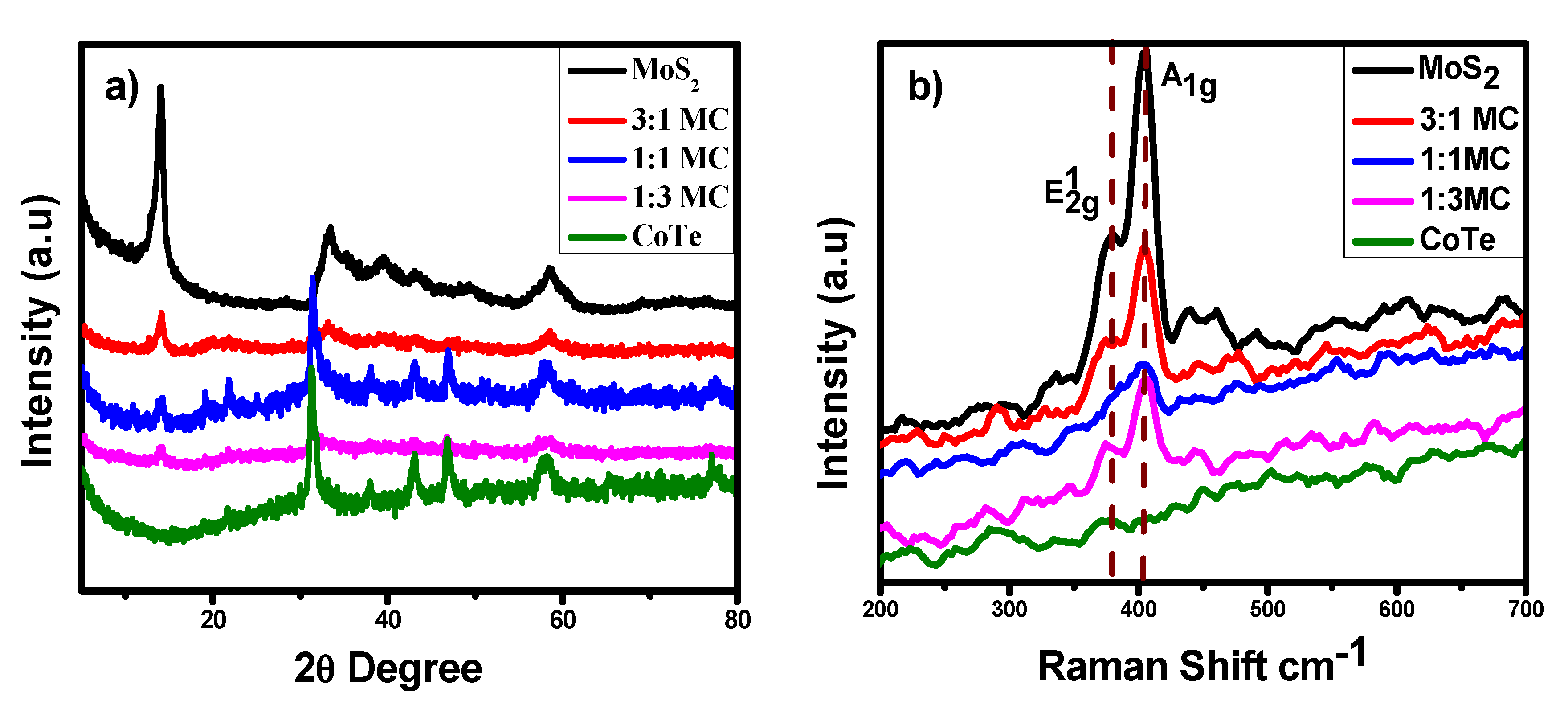
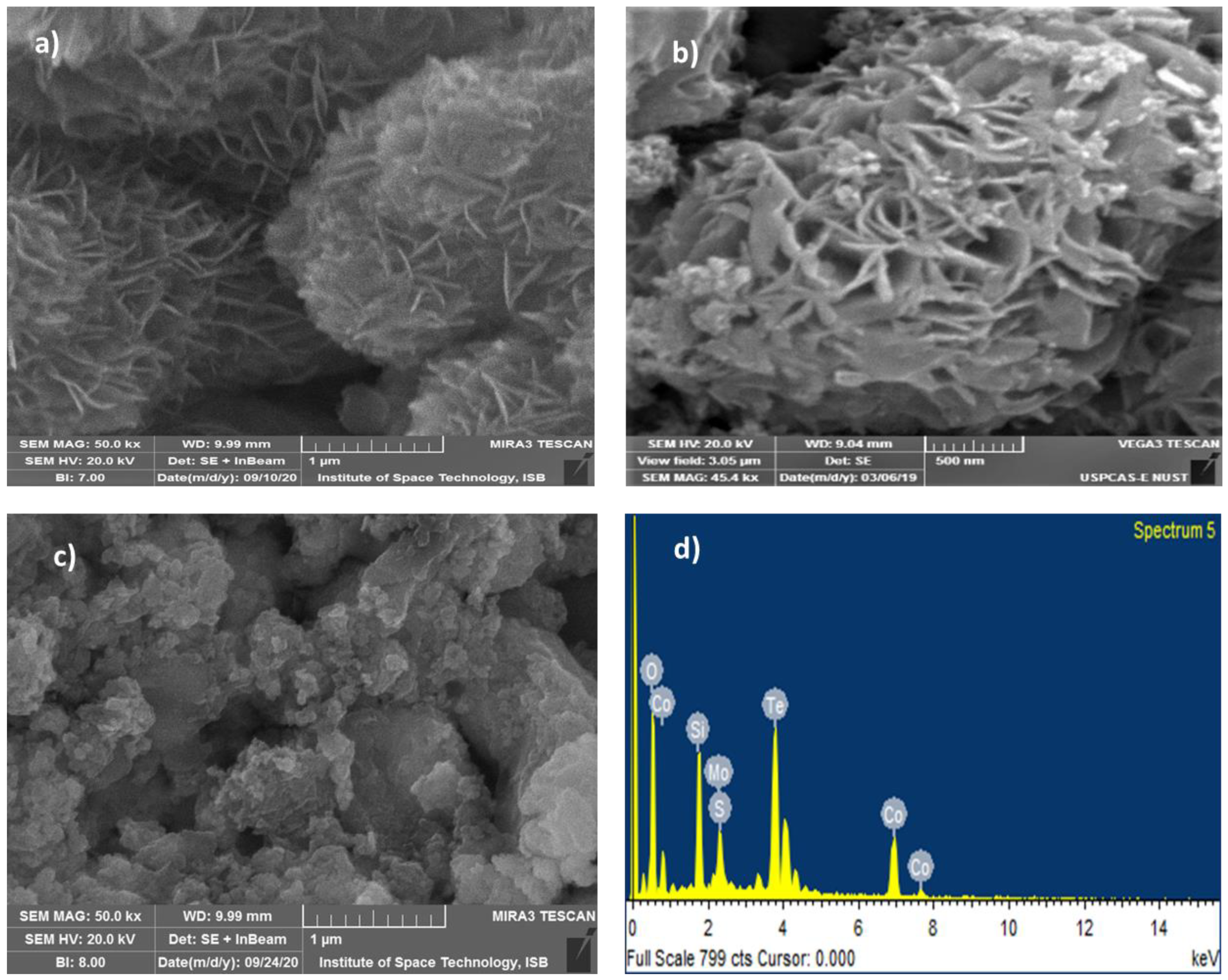
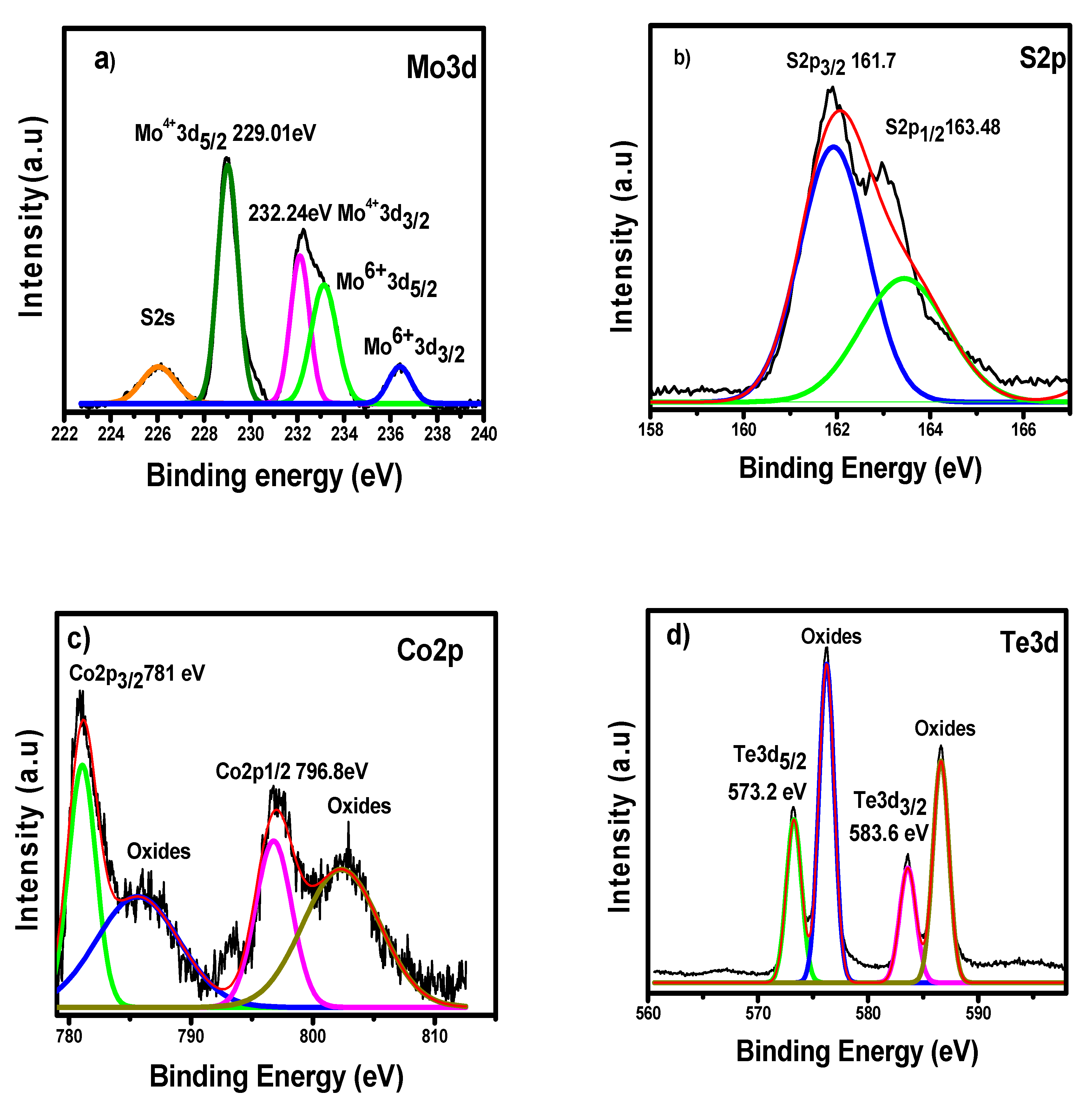


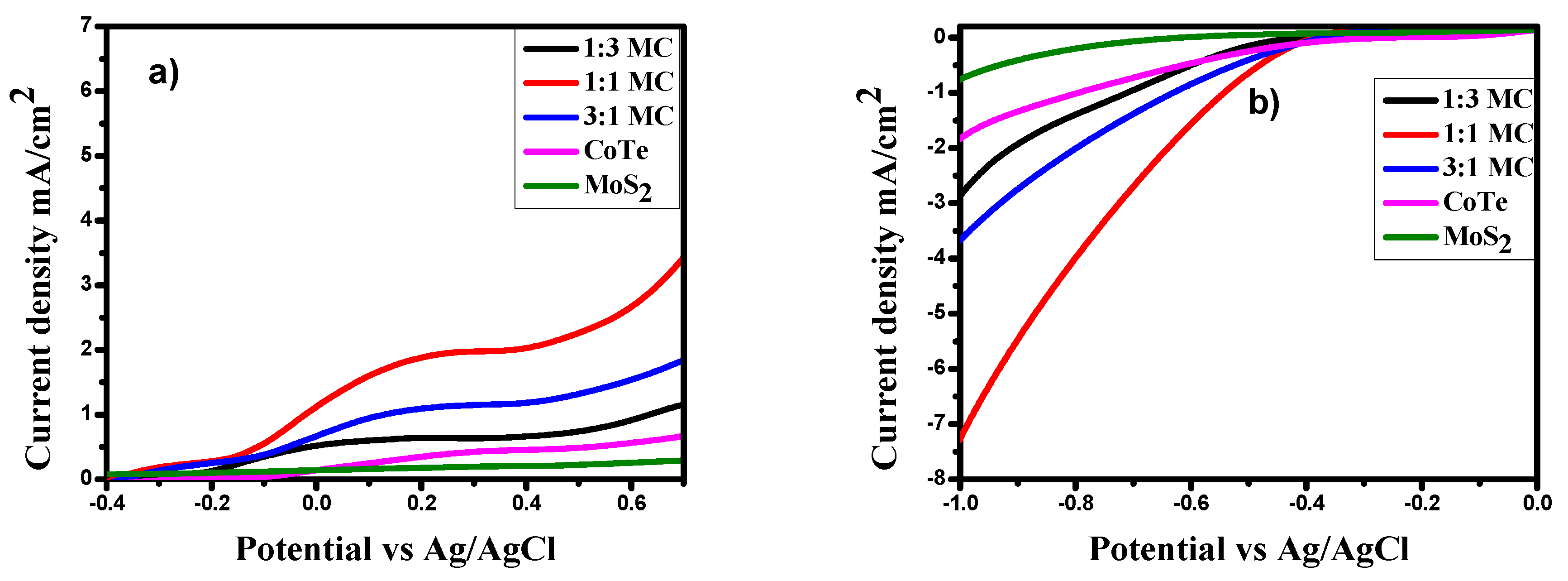

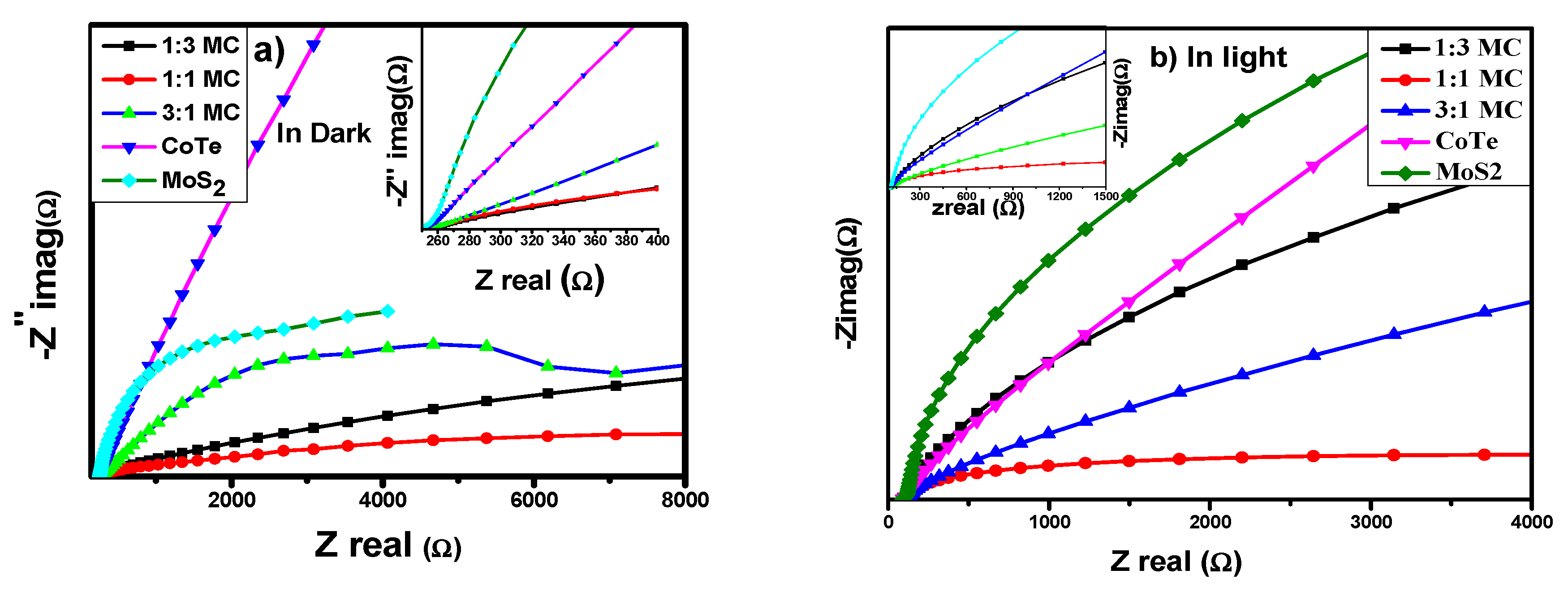


| S.No. | Heterostructures | Method | Electrolyte pH | Photocurrent Density | Ref. |
|---|---|---|---|---|---|
| 1. | MoS2/CoTe | Ultrasonication | 0.5M Na2SO4 pH = 7 | 2.79 mA/cm2 | This work |
| 2. | ZnO@MoSx | Electrodeposition | 0.5 M Na2SO4 pH = 7 | 1.42 mA/cm2 | [51] |
| 3. | NaNbO3/MoS2 | Hydrothermal | 0.5 M Na2SO4 pH = 7 | 3.56 mA cm−2 | [52] |
| 4. | In2Se3/MoS2 | Ultrasonication | 1 M Na2SO4 pH = 7 | 8 µA/cm2 | [53] |
| 5. | Au-MoS2 | Stirring | 0.1 M KH2PO4 pH = 7 | 790 μA/cm2 | [29] |
| 6. | MoS2/BiVO4 | Hydrothermal | 1 M Na2SO4 pH = 7 | 0.63 mA/cm2 | [54] |
Publisher’s Note: MDPI stays neutral with regard to jurisdictional claims in published maps and institutional affiliations. |
© 2020 by the authors. Licensee MDPI, Basel, Switzerland. This article is an open access article distributed under the terms and conditions of the Creative Commons Attribution (CC BY) license (http://creativecommons.org/licenses/by/4.0/).
Share and Cite
Sitara, E.; Nasir, H.; Mumtaz, A.; Ehsan, M.F.; Sohail, M.; Iram, S.; Bukhari, S.A.B. Efficient Photoelectrochemical Water Splitting by Tailoring MoS2/CoTe Heterojunction in a Photoelectrochemical Cell. Nanomaterials 2020, 10, 2341. https://doi.org/10.3390/nano10122341
Sitara E, Nasir H, Mumtaz A, Ehsan MF, Sohail M, Iram S, Bukhari SAB. Efficient Photoelectrochemical Water Splitting by Tailoring MoS2/CoTe Heterojunction in a Photoelectrochemical Cell. Nanomaterials. 2020; 10(12):2341. https://doi.org/10.3390/nano10122341
Chicago/Turabian StyleSitara, Effat, Habib Nasir, Asad Mumtaz, Muhammad Fahad Ehsan, Manzar Sohail, Sadia Iram, and Syeda Aqsa Batool Bukhari. 2020. "Efficient Photoelectrochemical Water Splitting by Tailoring MoS2/CoTe Heterojunction in a Photoelectrochemical Cell" Nanomaterials 10, no. 12: 2341. https://doi.org/10.3390/nano10122341





